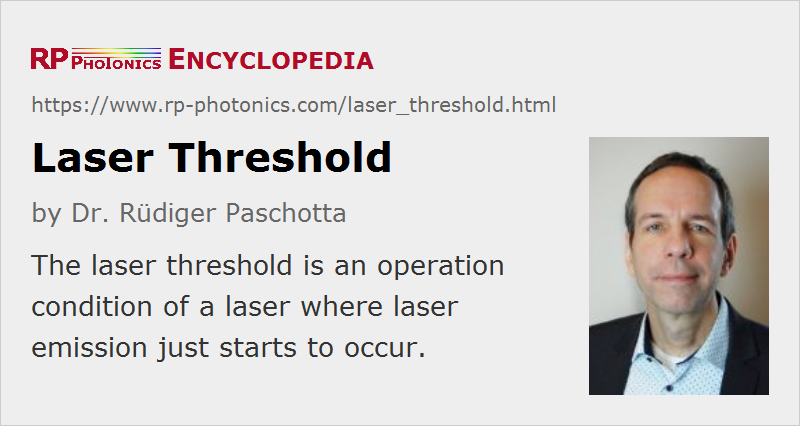Laser Threshold
Definition: an operation condition of a laser where laser emission just starts to occur
German: Laserschwelle
Category:  laser devices and laser physics
laser devices and laser physics
Author: Dr. Rüdiger Paschotta
Cite the article using its DOI: https://doi.org/10.61835/f7d
Get citation code: Endnote (RIS) BibTex plain textHTML
The threshold of a laser is the state where the small-signal gain just equals the resonator losses, so that laser emission can just begin. This is the case for a certain pump power (the threshold pump power), or (for electrically pumped lasers) a certain threshold current. Significant power output, good power efficiency and stable, low-noise performance requires operation well above the threshold. Typically, one operates a laser between 3 and 10 times above threshold.

The “edge” occurring at the threshold is very slightly rounded due to the influence of amplified spontaneous emission.
The threshold pump power can often be quite easily calculated based on the requirement that the small-signal round-trip gain reaches the level of the round-trip power losses at the laser wavelength. See the article on threshold pump power for an example.
A low threshold power requires low resonator losses and a high gain efficiency, the latter being achieved e.g. by using a small laser mode area in an efficient gain medium with limited emission bandwidth. The optimization of the laser output power for a given pump power usually involves a compromise between high slope efficiency and low laser threshold. However, an overall optimization of laser performance may have to take into account additional aspects, such as the achievable pulse duration in a Q-switched laser, avoiding Q-switching instabilities in a mode-locked laser, or minimizing thermal effects. The question of which value is most appropriate for the threshold pump power is one of the issues of laser design.
Even for operation below the laser threshold, the gain medium emits luminescence (for optically pumped lasers, this can be called fluorescence). Above threshold (in continuous-wave operation), the intensity level of the luminescence is typically clamped to values close to that at the laser threshold (→ gain clamping). Just below threshold, a laser already emits some power which results from amplified spontaneous emission and has a bandwidth which is large compared with the above-threshold laser emission, but small compared with the regular luminescence bandwidth.
The fundamental origin of the laser threshold is the power loss via luminescence into a large number of spatial modes (propagating in all directions). Under certain circumstances, it is possible to obtain a thresholdless laser by suppressing the luminescence with a microcavity. That can be realized, for example, based on the principle of photonic band gaps in photonic crystals.
Most lasers are operated with a pump power which is just a few times the threshold pump power, i.e., the pump parameter is often order of 3–10. This is often a good regime, since a lower threshold could not significantly increase the efficiency but could introduce problems related to, e.g., too high intracavity intensities.
More to Learn
Encyclopedia articles:
Blog articles:
Questions and Comments from Users
Here you can submit questions and comments. As far as they get accepted by the author, they will appear above this paragraph together with the author’s answer. The author will decide on acceptance based on certain criteria. Essentially, the issue must be of sufficiently broad interest.
Please do not enter personal data here; we would otherwise delete it soon. (See also our privacy declaration.) If you wish to receive personal feedback or consultancy from the author, please contact him, e.g. via e-mail.
By submitting the information, you give your consent to the potential publication of your inputs on our website according to our rules. (If you later retract your consent, we will delete those inputs.) As your inputs are first reviewed by the author, they may be published with some delay.


Share this with your friends and colleagues, e.g. via social media:
These sharing buttons are implemented in a privacy-friendly way!